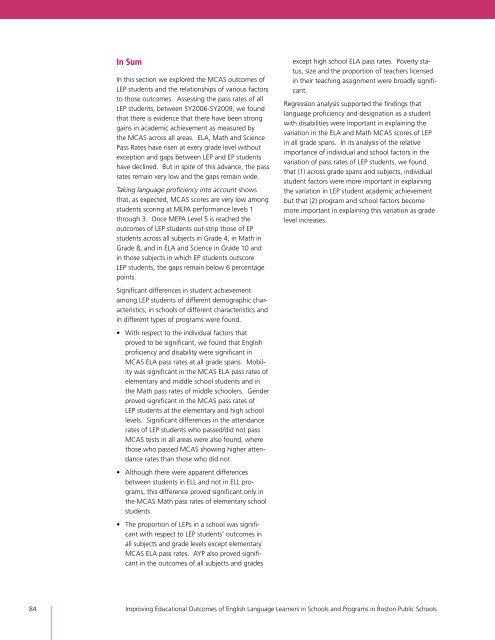Full Report - Center for Collaborative Education
Full Report - Center for Collaborative Education
Full Report - Center for Collaborative Education
Create successful ePaper yourself
Turn your PDF publications into a flip-book with our unique Google optimized e-Paper software.
In Sum<br />
In this section we explored the MCAS outcomes of<br />
LEP students and the relationships of various factors<br />
to those outcomes. Assessing the pass rates of all<br />
LEP students, between SY2006-SY2009, we found<br />
that there is evidence that there have been strong<br />
gains in academic achievement as measured by<br />
the MCAS across all areas. ELA, Math and Science<br />
Pass Rates have risen at every grade level without<br />
exception and gaps between LEP and EP students<br />
have declined. But in spite of this advance, the pass<br />
rates remain very low and the gaps remain wide.<br />
Taking language proficiency into account shows<br />
that, as expected, MCAS scores are very low among<br />
students scoring at MEPA per<strong>for</strong>mance levels 1<br />
through 3. Once MEPA Level 5 is reached the<br />
outcomes of LEP students out-strip those of EP<br />
students across all subjects in Grade 4, in Math in<br />
Grade 8, and in ELA and Science in Grade 10 and<br />
in those subjects in which EP students outscore<br />
LEP students, the gaps remain below 6 percentage<br />
points.<br />
Significant differences in student achievement<br />
among LEP students of different demographic characteristics,<br />
in schools of different characteristics and<br />
in different types of programs were found.<br />
• With respect to the individual factors that<br />
proved to be significant, we found that English<br />
proficiency and disability were significant in<br />
MCAS ELA pass rates at all grade spans. Mobility<br />
was significant in the MCAS ELA pass rates of<br />
elementary and middle school students and in<br />
the Math pass rates of middle schoolers. Gender<br />
proved significant in the MCAS pass rates of<br />
LEP students at the elementary and high school<br />
levels. Significant differences in the attendance<br />
rates of LEP students who passed/did not pass<br />
MCAS tests in all areas were also found, where<br />
those who passed MCAS showing higher attendance<br />
rates than those who did not.<br />
• Although there were apparent differences<br />
between students in ELL and not in ELL programs,<br />
this difference proved significant only in<br />
the MCAS Math pass rates of elementary school<br />
students.<br />
• The proportion of LEPs in a school was significant<br />
with respect to LEP students’ outcomes in<br />
all subjects and grade levels except elementary<br />
MCAS ELA pass rates. AYP also proved significant<br />
in the outcomes of all subjects and grades<br />
except high school ELA pass rates. Poverty status,<br />
size and the proportion of teachers licensed<br />
in their teaching assignment were broadly significant.<br />
Regression analysis supported the findings that<br />
language proficiency and designation as a student<br />
with disabilities were important in explaining the<br />
variation in the ELA and Math MCAS scores of LEP<br />
in all grade spans. In its analysis of the relative<br />
importance of individual and school factors in the<br />
variation of pass rates of LEP students, we found<br />
that (1) across grade spans and subjects, individual<br />
student factors were more important in explaining<br />
the variation in LEP student academic achievement<br />
but that (2) program and school factors become<br />
more important in explaining this variation as grade<br />
level increases.<br />
84 Improving <strong>Education</strong>al Outcomes of English Language Learners in Schools and Programs in Boston Public Schools


